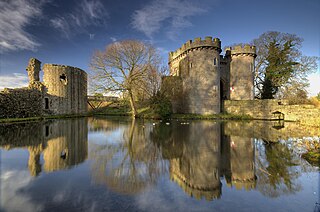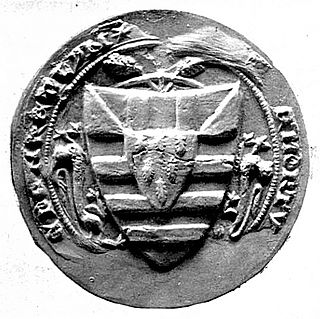Related Research Articles

The Kingdom of Powys was a Welsh successor state, petty kingdom and principality that emerged during the Middle Ages following the end of Roman rule in Britain. It very roughly covered the northern two-thirds of the modern county of Powys and part of today's English West Midlands. More precisely, and based on the Romano-British tribal lands of the Ordovices in the west and the Cornovii in the east, its boundaries originally extended from the Cambrian Mountains in the west to include the modern West Midlands region of England in the east. The fertile river valleys of the Severn and Tern are found here, and this region is referred to in later Welsh literature as "the Paradise of Powys".
Sir Henry Lingen, Lord of Sutton, Lingen and Stoke Edith, was a Royalist military commander in Herefordshire during the English Civil War, and later a member of parliament. He was the son of Edward Lingen and Blanche Bodenham. He fathered 2 sons, Henry and William and 7 daughters, Elizabeth, Joan, Blanch, Mary (Dobbyns), Cecilia, Frances (Unett), and Alice (Herring). Both sons died without issue but the daughters left considerable posterity.

Fulk FitzWarin, variant spellings, the third, was a prominent representative of a marcher family associated especially with estates in Shropshire and at Alveston in Gloucestershire. In young life, early in the reign of King John (1199–1216), he won notoriety as the outlawed leader of a roving force striving to recover his familial right to Whittington Castle in Shropshire, which John had granted away to a Welsh claimant. Progressively rehabilitated, and enjoying his lordship, he endured further setbacks in 1215–1217.

Powys Wenwynwyn or Powys Cyfeiliog was a Welsh kingdom which existed during the high Middle Ages. The realm was the southern portion of the former princely state of Powys which split following the death of Madog ap Maredudd of Powys in 1160: the northern portion (Maelor) went to Gruffydd Maelor and eventually became known as Powys Fadog; while the southern portion (Cyfeiliog) going to Owain Cyfeiliog and becoming known, eventually, as Powys Wenwynwyn after Prince Gwenwynwyn ab Owain, its second ruler.

Dinas Mawddwy is a village in the community of Mawddwy in south-east Gwynedd, north Wales. It lies within the Snowdonia National Park, but just to the east of the main A470, and consequently many visitors pass the village by. Its population is roughly 600. The village marks the junction of the unclassified road to Llanuwchllyn which climbs up through the mountains to cross Bwlch y Groes at its highest point, the second highest road pass in Wales. This minor road also provides the closest access to the mountain Aran Fawddwy and is the nearest settlement to Craig Cywarch.
Gruffydd ap Gwenwynwyn was a Welsh king who was lord of the part of Powys known as Powys Wenwynwyn and sided with Edward I in his conquest of Wales of 1277 to 1283.

Gruffydd Maelor was Prince of Powys Fadog in Wales.
Gruffydd Maelor II was Prince of Powys Fadog.
Owen de la Pole, also known as Owain ap Gruffydd ap Gwenwynwyn, was the heir presumptive to the Welsh principality of Powys Wenwynwyn until 1283 when it was abolished by the Parliament of Shrewsbury. He became the 1st Lord of Powis after the death of his father Gruffydd ap Gwenwynwyn c. 1287. He is not related to the English de la Pole family descended from William de la Pole, Chief Baron of the Exchequer in the following century, later Earls and Dukes of Suffolk.

Whittington Castle is a castle in northern Shropshire, England, owned and managed by the Whittington Castle Preservation Fund. The castle was originally a motte-and-bailey castle, but this was replaced in the 13th century by one with buildings around a courtyard whose exterior wall was the curtain wall of the inner bailey. As a castle of the Welsh Marches, it was built on the border of Wales and England very close to the historic fort of Old Oswestry.

Baron FitzWarin was a title in the Peerage of England created by writ of summons for Fulk V FitzWarin in 1295. His family had been magnates for nearly a century, at least since 1205 when his grandfather Fulk III FitzWarin obtained Whittington Castle near Oswestry, which was their main residence and the seat of a marcher lordship.

Maud 'Matilda' le Vavasour, Baroness Butler was an Anglo-Norman heiress and the wife of Fulk FitzWarin, a medieval landed gentleman who was forced to become an outlaw in the early 13th century, who is allegedly linked to the tale of Robin Hood and its origins.

John Charlton, 1st Baron Charlton of Powys (1268–1353) came from a family of minor landowners near Wellington, Shropshire. He was the son of Robert Charlton of Apley castle near Wrockwardine.

The Royal House of Mathrafal began as a cadet branch of the Welsh Royal House of Dinefwr, taking their name from Mathrafal Castle, their principal seat and effective capital. They effectively replaced the House of Gwertherion, who had been ruling the Kingdom of Powys since late Roman Britain, through the politically advantageous marriage of an ancestor, Merfyn the Oppressor. His son, King Bleddyn ap Cynfyn, would join the resistance of the Anglo-Saxon King Harold Godwinson, against the invasion of William the Conqueror, following the Norman conquest of England. Thereafter, they would struggle with the Plantagenets and the remaining Welsh Royal houses for the control of Wales. Although their fortunes rose and fell over the generations, they are primarily remembered as Kings of Powys and last native Prince of Wales.

Roger Mortimer, 1st Baron Mortimer of Chirk was a 14th-century Marcher lord, notable for his opposition to Edward II of England during the Despenser War.
Greyfriars, Shrewsbury was a friary in Shropshire, England.

Sir Roger Corbet, of Moreton Corbet, Shropshire was a landowner and politician who was a knight of the shire for Shropshire in three Parliaments of England. He was involved in a series of complex and sharply contested property disputes with members of his own family.
Hawise Lestrange was the daughter of the Marcher lord John Lestrange (d.1269) of Great Ness, Cheswardine and Knockin (Shropshire). Married at a young age to the ruler of southern Powys, Gruffudd ap Gwenwynwyn, she became a key figure in border affairs and in the management of her family and estates until her death at a great age. She was deeply implicated in a plot to overthrow the prince of Wales, Llywelyn ap Gruffudd, in 1274, and with her husband sided with Edward I in the English king's conquest of Wales.
Hawys Gadarn (Hawys ferch Owain ap Gruffudd ap Gwenwynwyn), also known as the Hardy, the Powerful, the Intrepid, and Hawise de la Pole, (1291 – c. 1353) was the daughter of Owen de la Pole and the heir to Powys Wenwynwyn in Wales. She was married to John Charleton after seeking the intervention of Edward II of England to support her inheritance against the schemes of four of her uncles to take her lands.
John III Lestrange, of Knockin in Shropshire, landowner, administrator and soldier, was a marcher lord defending England along its border with Wales.
References
- G. T. O. Bridgeman, 'The Princes of upper Powys', Montgomeryshire Collections I (1868), 52 59 77ff.
- ↑ Cokayne, The Complete Peerage , new edition, XII(1), s.v. Suffolk, Earl.
- ↑ Visitation of Shropshire in 1623, Robert Tresswell Somerset herald